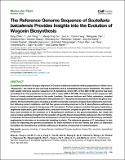The Reference Genome Sequence of Scutellaria baicalensis Provides Insights into the Evolution of Wogonin Biosynthesis
Author(s)
Weng, Jing-Ke; Pluskal, Tomáš
DownloadPublished version (3.425Mb)
Publisher with Creative Commons License
Publisher with Creative Commons License
Creative Commons Attribution
Terms of use
Metadata
Show full item recordAbstract
Scutellaria baicalensis Georgi is important in Chinese traditional medicine where preparations of dried roots, "Huang Qin," are used for liver and lung complaints and as complementary cancer treatments. We report a high-quality reference genome sequence for S. baicalensis where 93% of the 408.14-Mb genome has been assembled into nine pseudochromosomes with a super-N50 of 33.2 Mb. Comparison of this sequence with those of closely related species in the order Lamiales, Sesamum indicum and Salvia splendens, revealed that a specialized metabolic pathway for the synthesis of 4'-deoxyflavone bioactives evolved in the genus Scutellaria. We found that the gene encoding a specific cinnamate coenzyme A ligase likely obtained its new function following recent mutations, and that four genes encoding enzymes in the 4'-deoxyflavone pathway are present as tandem repeats in the genome of S. baicalensis. Further analyses revealed that gene duplications, segmental duplication, gene amplification, and point mutations coupled to gene neo- and subfunctionalizations were involved in the evolution of 4'-deoxyflavone synthesis in the genus Scutellaria. Our study not only provides significant insight into the evolution of specific flavone biosynthetic pathways in the mint family, Lamiaceae, but also will facilitate the development of tools for enhancing bioactive productivity by metabolic engineering in microbes or by molecular breeding in plants. The reference genome of S. baicalensis is also useful for improving the genome assemblies for other members of the mint family and offers an important foundation for decoding the synthetic pathways of bioactive compounds in medicinal plants.
Date issued
2019-07Department
Whitehead Institute for Biomedical Research; Massachusetts Institute of Technology. Department of BiologyJournal
Molecular plant
Publisher
Elsevier BV
Citation
Zhao, Qing et al. "The Reference Genome Sequence of Scutellaria baicalensis Provides Insights into the Evolution of Wogonin Biosynthesis." Molecular plant 12 (2019): 935-950 © 2019 The Author(s)
Version: Final published version
ISSN
1674-2052
Keywords
Plant Science, Molecular Biology